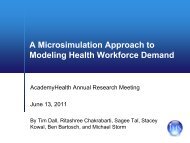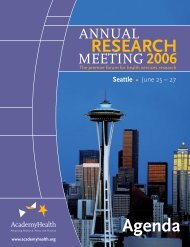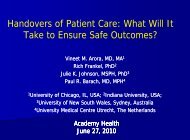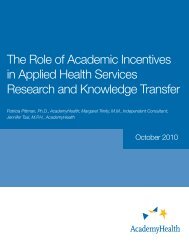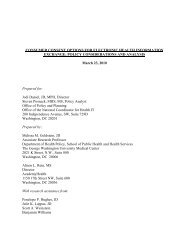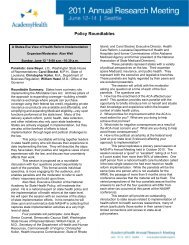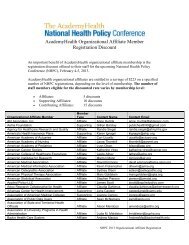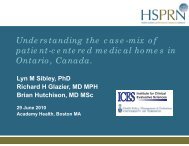The Growing Case for Using Physician Incentives to - AcademyHealth
The Growing Case for Using Physician Incentives to - AcademyHealth
The Growing Case for Using Physician Incentives to - AcademyHealth
Create successful ePaper yourself
Turn your PDF publications into a flip-book with our unique Google optimized e-Paper software.
NHCPI/MONOGRAPH<br />
10<br />
A 1997 survey of Cali<strong>for</strong>nia PCPs helps quantify<br />
the sense that while health plans’ use of financial<br />
incentives <strong>for</strong> physicians is common, the<br />
application of these incentives <strong>to</strong> improve quality<br />
is comparatively rare. Almost 40 percent of<br />
the respondents reported facing some type of<br />
financial incentive in their health plan contracts<br />
while only 18 percent reported facing financial<br />
incentives linked <strong>to</strong> quality of care. 8 Further,<br />
these Cali<strong>for</strong>nia physicians were three times<br />
more likely <strong>to</strong> report facing quality incentives if<br />
they were practicing in a group or staff model<br />
health plan. Recent newspaper articles suggest<br />
that health plan’s use of financial incentives<br />
linked <strong>to</strong> quality measures may be increasing. 9<br />
Cali<strong>for</strong>nia physicians surveyed were three<br />
times more likely <strong>to</strong> report facing quality<br />
incentives if they were practicing in a group<br />
or staff model health plan.<br />
Where they do exist, financial incentives <strong>for</strong><br />
quality improvement vary along a number of<br />
dimensions, such as the percentage of a<br />
physician’s income at stake, the organizational<br />
level at which the incentive is applied, and the<br />
relationship and synergy between multiple<br />
financial and non-financial incentives. 10 <strong>The</strong><br />
size of the financial incentives used by health<br />
plans and medical groups tends <strong>to</strong> range from<br />
1 <strong>to</strong> 20 percent of a physician’s <strong>to</strong>tal compensation,<br />
with many incentives clustered in the 5<br />
percent range. <strong>The</strong> size of the incentive varies<br />
partially in relationship <strong>to</strong> the type of<br />
organization applying the incentive. For<br />
example, physicians in staff or group model<br />
health plans tend <strong>to</strong> face financial incentives<br />
that account <strong>for</strong> a greater portion of their<br />
overall compensation. In an independent practice<br />
association (IPA), however, where the health<br />
plan may only have 30 percent of the provider’s<br />
overall business, any financial incentive applied<br />
by that IPA is likely <strong>to</strong> account <strong>for</strong> much less than<br />
10 percent of a provider’s <strong>to</strong>tal compensation.<br />
8 Grumbach, Kevin MD, Dennis Osmond Ph.D., et al, “PCP’s Experience of Financial <strong>Incentives</strong> in Managed Care<br />
Systems,” <strong>The</strong> New England Journal of Medicine, Vol. 339, No. 21, November 19, 1998: pp. 1516-1521.<br />
9 Boodman, Sandra G, “Paying Docs <strong>to</strong> Do the Right Thing,” <strong>The</strong> Washing<strong>to</strong>n Post, July 3, 2001, p. HE07; Appleby, Julie,<br />
“HMO <strong>to</strong> Pay Bonuses <strong>for</strong> Good Care,” USA Today, July 11, 2001, p. 3B.<br />
10 Magnus, Stephen, “<strong>Physician</strong>s’ Financial <strong>Incentives</strong> in Five Dimensions: A Conceptual Framework <strong>for</strong> Managers,” Health<br />
Care Management Review, Winter 1999: pp. 57-72.





